A Spotty Sun, Comet E3 Enters Evening, Pre-dawn Lunar Libration, Mercury in Morning, Venus Smooches Saturn at Sunset, and a Taurus Tour!
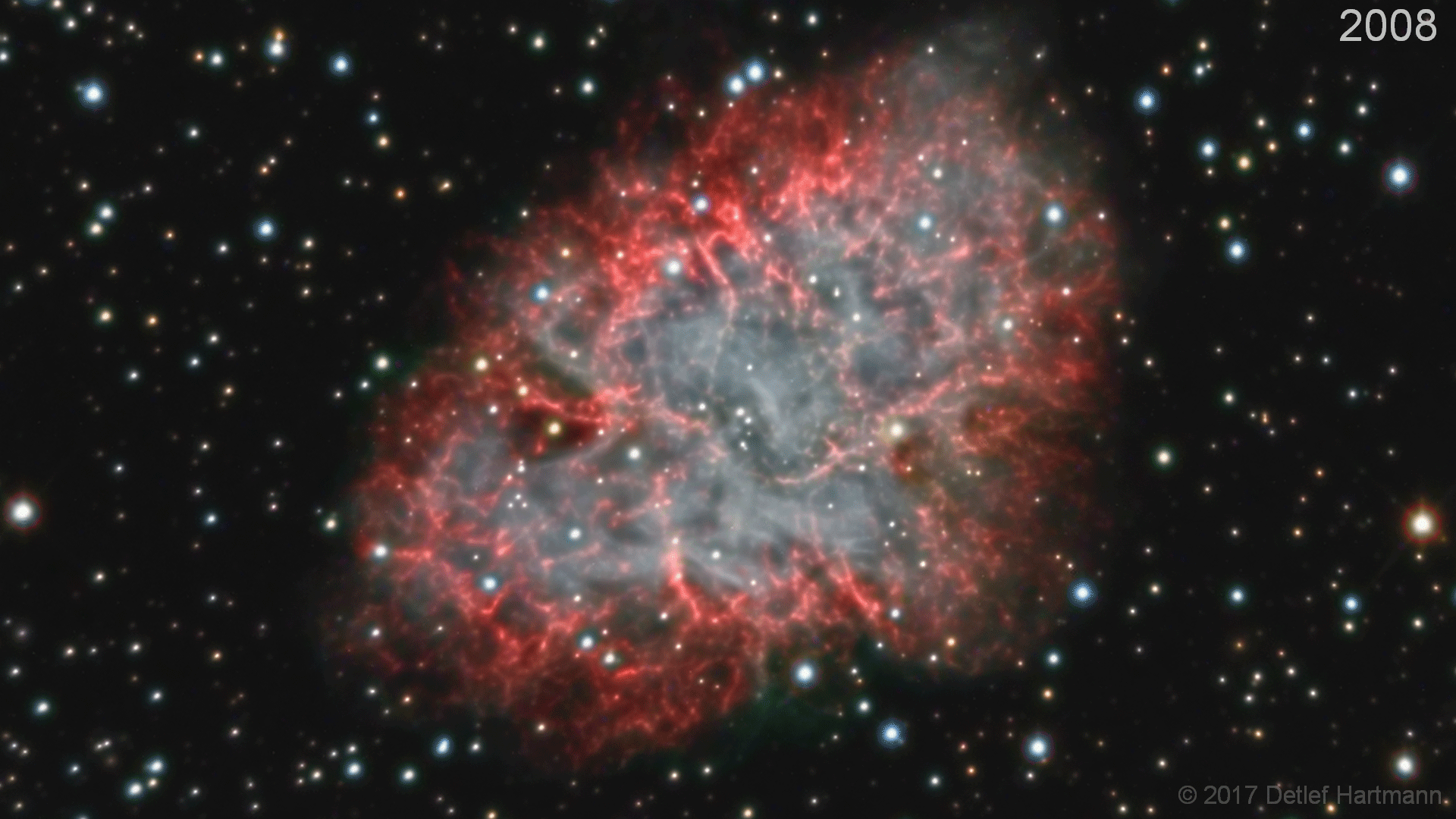
This amazing composite image by Detlef Hartmann shows the continued expansion of the Crab Nebula Supernova Remnant (aka Messier 1) in Taurus over 10 years (Sept 29, 2008 through Sept 22, 2017). It spans about 0.1 degrees of the sky. In the heart of the nebula sits a rapidly rotating neutron star that emits radio waves. They sweep across our detectors 30 times per second light a fast lighthouse’s beam. The intense radiation causes the gas in the cloud to glow. Detlef’s original image can be viewed at Astrobin https://www.astrobin.com/327338/0/
Hello, Mid-January Stargazers!
Here are your Astronomy Skylights for the week of January 15th, 2023 by Chris Vaughan. Feel free to pass this along to your friends and send me your comments, questions, and suggested topics. You can also follow me on Twitter as @astrogeoguy! Unless otherwise noted, all times are expressed in Eastern Time. To subscribe to these emails please click this MailChimp link.
If you’d like me to bring my Digital Starlab portable inflatable planetarium to your school or other daytime or evening event, or deliver a session online, contact me through AstroGeo.ca, and we’ll tour the Universe, or the Earth’s interior, together! My terrific book with John A. Read entitled 110 Things to See With a Telescope is a guide to viewing the deep sky objects in the Messier List – for both beginners and seasoned astronomers. DM me to order a signed copy!
The sun is incredibly active now – grab your eclipse viewers! The moon will vacate the night sky worldwide this week, allowing us to see better the comets C/2022 E3 (ZTF) and C/2020 V2 (ZTF), both now in evening! Mercury has joined the morning sky, Venus will kiss Saturn in a very close conjunction, and Jupiter and Mars will continue to dazzle in evening. Finally, I highlight the best sights to see in the ancient constellation of Taurus, the Bull. Read on for your Skylights!
The Sun is Spotty!
The sun is swarming with spots this weekend. Pull out your eclipse viewers and specially filtered telescopes!
The intense fusion reactions inside the sun and the flow of ionized particles (mainly Hydrogen atoms split into their components of one proton and one electron) combine to give the sun an intense magnetic field. Since the sun is a sphere of compressed gases, and not a solid ball like Earth, its rotation is differential. A point on the sun’s equator will circle the star once in 24.47 Earth days, but a point close to its northern or southern pole will take almost 38 days! The sun’s average rotation period of 28 days closely matches our moon’s orbital period – but that’s a mere coincidence of nature.
The differential rotation causes the sun’s global magnetic field to wind up tighter over time. Magnetic fields can’t merge or cross one another. (That’s why it’s difficult to push the same poles of two magnets together.) As the sun’s field tightens up, small regions within it develop tangles of magnetism that prevent the heat beneath them from flowing out of the sun. Those cooler areas are visible from Earth as sunspots. Astronomers formally call them active regions, and number them.
Sunspots can develop, grow, and fade in hours and days – or persist for weeks. Viewed from Earth, they take about two weeks to cross the sun’s disk – allowing us time to view the changes. Scientists have also placed satellites on the far side of the sun to watch the solar hemisphere that we can’t see. That’s because, from time to time, the buildup of energy in those tangles gets violently released as solar flares, and as eruptions of matter into space called coronal mass ejections. Those events, which happen in minutes, cause the auroras at Earth’s polar regions to grow stronger. They also endanger orbiting astronauts and satellites with intense radiation – if Earth happens to be in the line of fire. The flares vary in intensity. They are ranked by class, from weak A-class to extreme M- and X-class. During a flare, the magnetic field lines are snapping and re-connecting into simpler configurations.
For a period of time, more and more spots appear, and more and more violent events occur. Eventually, the sun sheds its excess energy, the magnetic fields smooth out, and the sun settles into a quiet period with no, or very few, sunspots and flares. Over the years, astronomers have been able to view the sun through filters, count the sunspots, and record their number in a log. It turns out that the sun needs about 11 Earth-years to build up and then wind down. Even more interestingly, the polarity of the magnetic field reverses with each sunspot cycle, producing a 22-year period between true cycles. There are lots of online sources showing graphs of the counts, including this page of recent ones and this one.
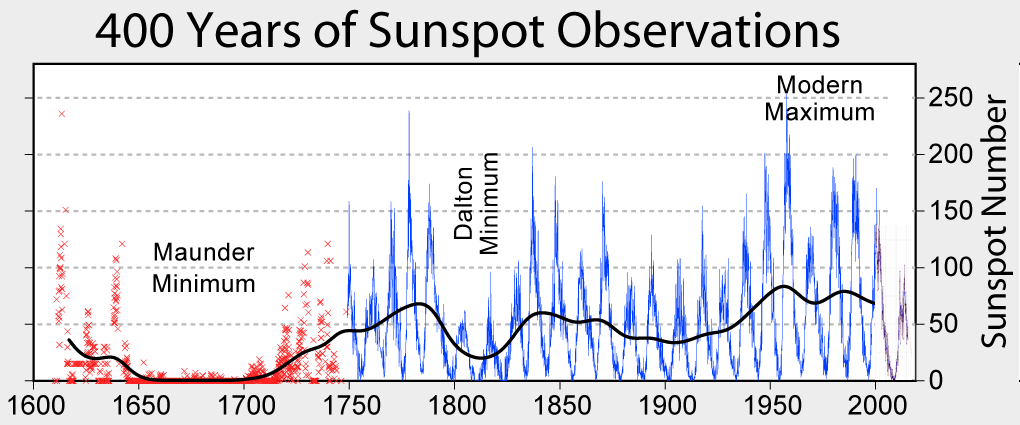
The round disk of the sun we see (through proper filters) is not the sun’s surface. Instead, it’s the radius where its gases cease to be opaque to visible light. (I like the analogy of the visible edge of a cumulus cloud in the sky. An airplane can still fly through the cloud.) This “visual surface” of the sun is called the photosphere. There, the temperature is about 5,500 degrees Celsius, or 5,777 K. That’s hot – but cool enough for non-ionized Hydrogen to survive, temporarily.
When a positively ionized Hydrogen nucleus grabs a passing electron, the atom settles down and emits a photon with a wavelength of 656.3 nanometres. That’s in the red part of the visible spectrum. Astronomers call that light HII (“H-two”) or Hydrogen-alpha light. Solar telescopes are designed to throw away all the other colours in the sun’s bright white light and pass only the H-alpha band to the eyepiece or camera.
For the past couple of years the sun has been ramping up its activity with more and more sunspots. When the spots are large enough or clumped together, they become visible through eclipse viewers without a telescope! Remember to never look at the sun without using proper solar filters on your eyes and your binoculars or telescopes! Your eyes do not have pain receptors, and will not warn you that they are being permanently damaged.
If you’ve obtained eclipse viewers at a public sun viewing session, a science shop, or in an astronomy magazine, dig them up and use them on the sun today. Be sure to put on and take off the viewers only while your face is turned away from the sun. I frequently check the current sun picture on Spaceweather.com. Today shows lots of them – arranged in sets across the northern and southern mid-latitudes of the sun. Let me know if you are able to see any.
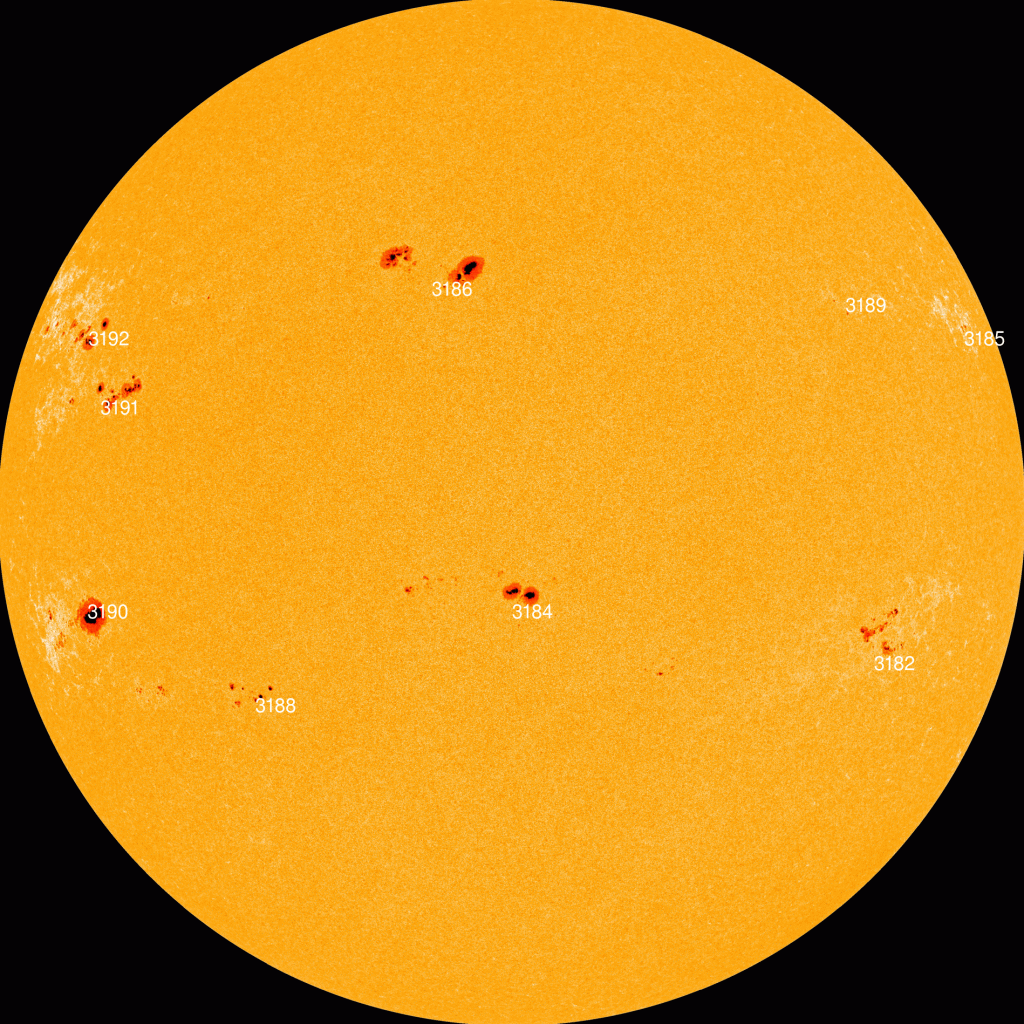
Comets Update
Here’s an update on the two comets that are currently available for viewing. Both were discovered by the robotic widefield camera of the Zwicky Transient Facility (or ZTF) on Mount Palomar in California, one in 2020 and the other in 2022. The comets’ positions around the north celestial pole mean that only sky-watchers in the Northern Hemisphere can see them.
Comet c/2022 E3 (ZTF) is predicted to become bright enough to see in binoculars, and possibly our unaided eyes, while it passes nearest to the Earth – at a distance of 43 million km – on February 1. The orbit of this comet is nearly perpendicular to the plane of our solar system. It is diving down (southward) through the solar system between the orbits of Earth and Mars. Comets normally display their largest coma (fuzzy head) and tail while they are nearest the sun. That perihelion event happened on January 12. They tend to appear brightest while they are closer to Earth. You can view and play with Comet E3’s orbit in 3D here.
Comet E3 has already become visible as a faint, greenish fuzzy patch in big binoculars and backyard telescopes under dark skies – but only during the pre-dawn hours. Astronomers have been estimating its brightness as about magnitude 6.5 to 7. This week, it will continue to brighten and become circumpolar for Northern Hemisphere observers, allowing us to see it from late evening onward! The green is produced when diatomic carbon released from the core is ionized by solar radiation.
Comet E3 will spend this week sliding northward, more or less towards the stars Kochab and Polaris in Ursa Minor (the Little Bear and Little Dipper). It will parallel the boundary dividing the constellation of Boötes (the Charioteer) and the keystone shape of Hercules to its lower left (or celestial east). At latitudes near Toronto, the comet will clear the northeastern rooftops around midnight local time – but the best time for viewing will be 2 to 6 am, when the comet will be higher in the sky. But that will change…
Tonight (Sunday) the comet will share the field of view in binoculars between the medium-bright stars Chi Herculis (or X Her) and the highly recognizable close-together pair of stars named Nu1,2 Boötis. The very bright star Arcturus will shine about three fist widths to their right. By 6 am the comet will be high in the east with Arcturus to its upper right.

Each night this week, the comet will slide a thumb’s width (or 1.5°) higher toward Polaris. By mid-week it will be high enough in the sky for viewing after 11 pm (though later will still yield better views). Next Sunday night it will be readily visible after 10 pm local time – sharing binoculars with the bright star Edasich in Draco (the Dragon). That night and Monday, astro-imagers should try for a photograph that shows the comet near several galaxies, including the Spindle Galaxy (Messier 102) and the Splinter Galaxy (NGC 5906).
The other ZTF comet, named C/2020 V2 (ZTF), is on the opposite side of Polaris near the W-shaped stars of Cassiopeia (the Queen). That location makes it available for viewing as soon as the sky darkens in evening – but you’ll need a telescope and a relatively dark location. The comet is currently only a faint, magnitude 9.5 fuzzy spot in large binoculars, but should show relatively well in 80-mm and larger telescopes, especially now that the moon has left the evening sky. Comet V2 passed closest to Earth in early January. It will remain at about the same brightness over the month as it dives through the plane of the solar system between the orbits of Mars and Jupiter. Its perihelion will be later this year. You can play with a nice interactive 3D model of its orbital path here.
This week Comet V2 will be travelling celestial southward on a line joining Polaris to the star Ruchbah (or Delta Cassiopeiae) in the shallower half of the W of Cassiopeia (the Queen). Since the northern sky rolls around the celestial pole during the night, that motion translates to upwards during evening – away from Polaris.
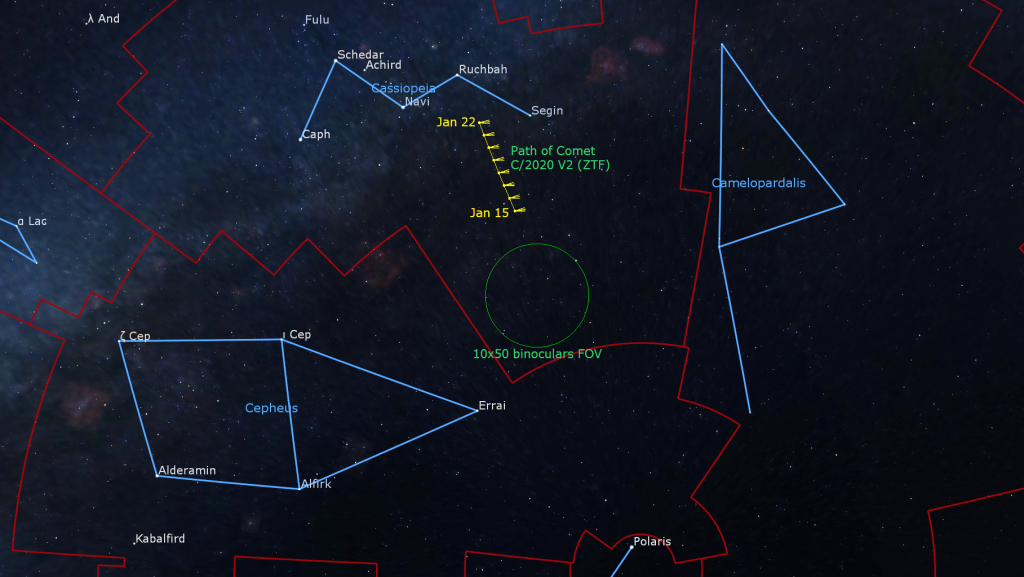
The comet is highest in the sky after dusk, and then it descends the sky on the western side of Polaris during evening – so try to view it right after dinner. (Don’t forget to chill down your telescope, with its lens caps on, in a secure location for an hour or two ahead of viewing.) Tonight (Sunday) the comet will be positioned a slim fist’s width (or 8.5°) from Ruchbah. On each subsequent night it will shift almost a finger’s width closer to Ruchbah, passing extremely close to that star on January 26! On the coming weekend, the comet will be positioned near the open star clusters NGC 609, NGC 559, and NGC 637. Take a photo!
The Moon
If you want to see the moon this week, you’ll have to wake up very early or settle for spying its pale crescent haunting the morning daytime sky until about Thursday. After that it will be too close to the sun. On the flip side, astronomers viewing the treasures of the winter constellations and winter Milky Way during evening will have nice, dark skies! Chill down that telescope!
I woke up early this morning to see the edge of Mare Orientale, the youngest of the moon’s great basins. Its English name “the Eastern Sea” belies its location on the moon’s western hemisphere. Due to the moon’s 1.5° axial tilt, its orbital inclination (or tilt) of 5° from the Earth’s orbital plane, and the moon’s orbital ellipticity (or out-of-roundness), the moon nods up-and-down by up to 7° and twists left-to-right up by to 8° while keeping the same hemisphere pointed towards Earth. Over time, this lunar libration effect lets us see an extra 9% of the moon’s total surface without having to leave the ground!
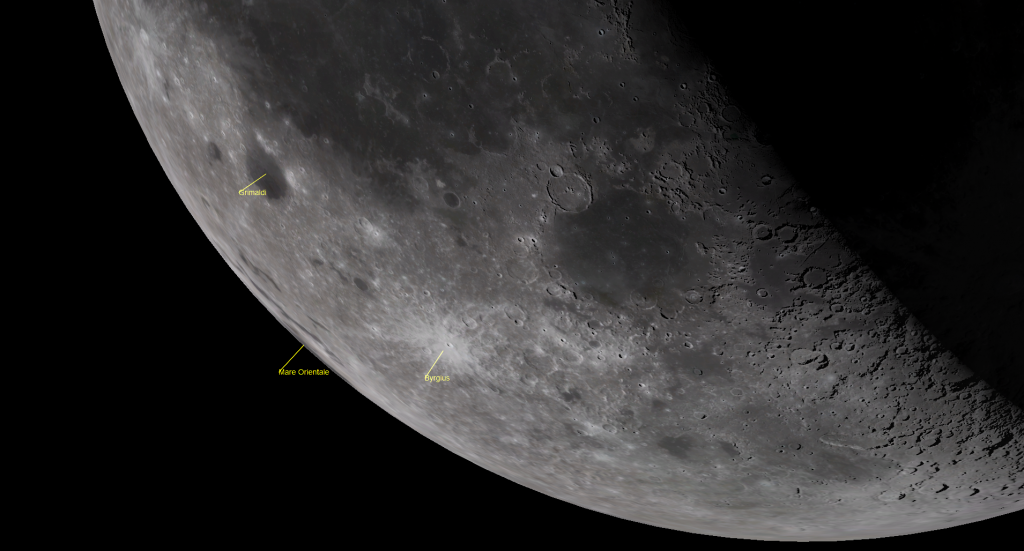
Lunar features that are normally smeared along the moon’s edge or completely hidden can rotate into clearer view for a few nights. The librated sector of the moon’s limb migrates clockwise around the moon over a lunar month – but librated features can only be observed if their sector happens to be bathed in sunlight at the same time.
Most of Mare Orientale can never be seen from Earth, but the easternmost section of its outer rings can. Late last week, the edge of the moon that hosts Mare Orientale was librated to maximum – but Sunday morning was my first opportunity with clear skies. Thankfully, there was still enough libration for me, and I got a terrific look. I used a large telescope, but any decent backyard telescope with a high magnification eyepiece will work. To see it, use binoculars or a telescope to first seek out the dark circular crater Grimaldi and the very bright, but small crater Byrgius to its south. Mare Orientale will appear as several elongated dark strips hugging the edge of the moon between those two craters. You should also look for some raised bumps along the moon’s edge – the basin’s rings in profile. After tomorrow morning, the next few windows of opportunity will be from late evening to morning around February 10, March 10, and April 7.

This morning’s moon was posing to the left of the bright star Spica in Virgo (the Maiden). On Monday morning, it will hop 12° east to shine as a pretty crescent to the right (celestial west) of the medium-bright double star named Zubenelgenubi or Alpha Librae1,2. You’ll be able to enjoy their scene until almost 7 am. Grab the binoculars and have a go!
On Tuesday morning, the waning crescent moon will sit in eastern Libra (the Scales), just a palm’s width to the right of the up-down row of small white stars that form the claws of Scorpius (the Scorpion). From top to bottom, the stars are named Jabbah or Nu Scorpii, Graffias or Acrab, Dschubba, Fang or Pi Scorpii, and Rho Scorpii. Graffias, Dschubba, and Fang are the brightest. A backyard telescope at high magnification will reveal that Nu Scorpii, Graffias, and Dschubba are close-together double stars. Those stars are actually the wrists of the scorpion’s pincers. Years ago, astronomers decided to take the original claw tip stars and use them to form Libra.
After the waning crescent moon rises in the southeastern pre-dawn sky on Wednesday morning, it will be shining just a thumb’s width to its left (or 1.5 degrees to the celestial east-northeast) of the bright, reddish star Antares, the heart of Scorpius (the Scorpion). The pair will be close enough to share the view in binoculars until the brightening sky hides Antares. Watch for Mercury shining well off to their lower left.
Low in the southeastern sky on Thursday morning before sunrise, the moon’s slim crescent will shine 1.4 fist diameters to the right of Mercury’s bright dot. Once you have spotted one of them, look for the other – but be sure to put binoculars away before the sun rises. That will be your last glimpse of the moon before it disappears ahead of new moon.
The moon will reach its new moon phase on Saturday, January 21 at 3:53 pm EST, 12:53 pm PST, or 20:53 Greenwich Mean Time. At that time our natural satellite will be located in southwestern Capricornus (the Sea-Goat), 5.5° south of the sun. This new moon will occur while the moon is at perigee, its closest approach to Earth, producing high tides worldwide. This new moon will kick off the Lunar New Year observed in many Asian countries. Since the new moon will happen on Sunday, Beijing-time, that will be the first day of the Chinese New Year worldwide, and the start of their Spring Festival 春节, or Chūn Jié (“CHWUN-jee-eh”), which runs until the full moon two weeks later. I’ll write more about that next week.
While new, the moon will be travelling between Earth and the sun. Since sunlight can only reach the far side of the moon, and the moon is in the same region of the sky as the sun, the moon will be unobservable from anywhere on Earth for about a day (except during a solar eclipse). Next week, Earth’s planetary partner will return to shine in the western sky after sunset.
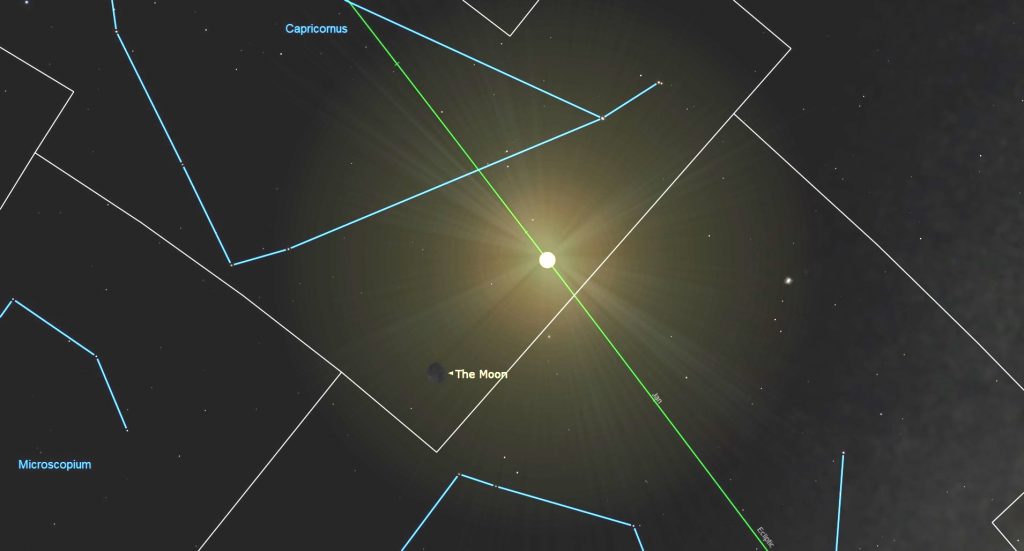
The Planets
With Mercury far enough west of the pre-dawn sun to be visible over the southeastern rooftops in morning this week, all the planets are back on the menu! The speedy innermost planet will rise by about 6:20 am local time and will climb a bit higher each morning. If you can see the bright stars Altair in Aquila (the Eagle) and Antares in Scorpius (the Scorpion), hunt for Mercury below and midway between them before the sky brightens too much. In a backyard telescope, Mercury will display a blurry, waxing crescent shape. It’ll become nearly half-illuminated next Sunday morning. The crescent moon will shine off to Mercury’s right on Thursday morning only.

At the other end of the day, Venus will shine extremely brightly above the rooftops in the southwestern sky after sunset. It, too, is climbing away from the sun, so it’ll appear higher in the sky at the same time each night. We’ll enjoy Venus as the “Evening Star” until next July! Our hot next-door planet will show a 93%-illuminated disk in your telescope, but clear views will not be possible through so much intervening air. For best results, view it as soon as you can find it. It’ll set by 7 pm local time. Be sure to wait until the sun has completely disappeared before searching for Venus (or Mercury) in binoculars or telescopes.
On the evenings surrounding Sunday, January 22, Venus will climb past 75 times fainter Saturn in a very close conjunction. The pair will shine above the west-southwestern horizon for an hour after sunset. The two planets will be cozy enough to share the view in binoculars from Friday to Tuesday. They’ll share the view in a backyard telescope from Saturday to Monday. At their closest approach on Sunday, Saturn will be positioned just half a finger’s width to Venus’ right (or 20 arc-minutes to the celestial north-northwest), but your telescope may flip them around. Observers at southerly latitudes might glimpse the very slim crescent of the young moon positioned nearly a fist’s width below the two planets on Sunday.
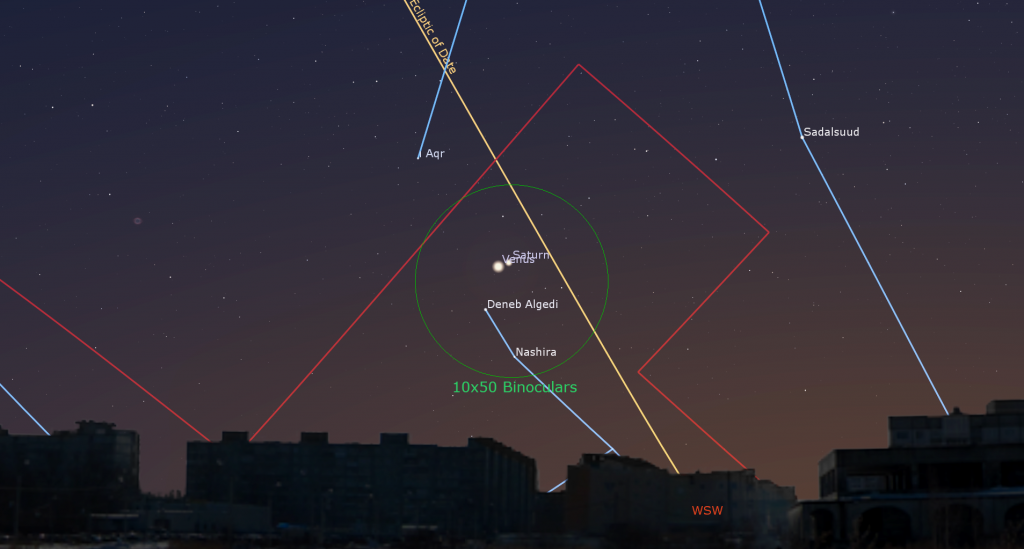
Our time for clear views of Saturn in a telescope will end soon, but even a small telescope can show the planet’s globe encircled by its glorious rings, and possibly its largest moon named Titan! Its orbit around Saturn will take it from the upper left of the planet on Sunday to Wednesday down to Saturn’s lower right for the balance of the week. As the sky darkens, the medium-bright tail stars of Capricornus (the Sea-Goat), brighter Deneb Algedi and half as bright Nashira will shine a thumb’s width to Saturn’s lower left (or celestial south).
We’ve got plenty of time to enjoy Jupiter in evening and Mars all night long. Jupiter’s bright, white, magnitude -2.3 dot will appear high in the southwestern sky after sunset. Your binoculars should be able to show Jupiter as a small disk bracketed by its line of four Galilean moons named Io, Europa, Ganymede, and Callisto. Those moons complete orbits of the planet every 1.7, 3.6, 7.2, and 16.7 days, respectively. If you see fewer than four moons, then one or more of them is crossing in front of or behind Jupiter, or hiding in Jupiter’s dark shadow – or two of the moons are very close together or occulting one another. The moons’ arrangement varies each night. All four of them will dance to the same side of the planet on Friday night.
On Friday, January 20, the giant planet Jupiter will reach perihelion, its minimum distance from the sun for its current 12-years-long orbit. Today Jupiter will be 740.659 million km, or 4.95 times the mean Earth-sun distance. From here on Earth Jupiter won’t look any larger or brighter tonight, but at Jupiter’s next six oppositions the planet will show a diminishing disk size in telescopes. Jupiter will grow in apparent size again during the years preceding the next perihelion on December 5, 2034, but it won’t be as close to the sun as it is tonight until the late 2050’s!
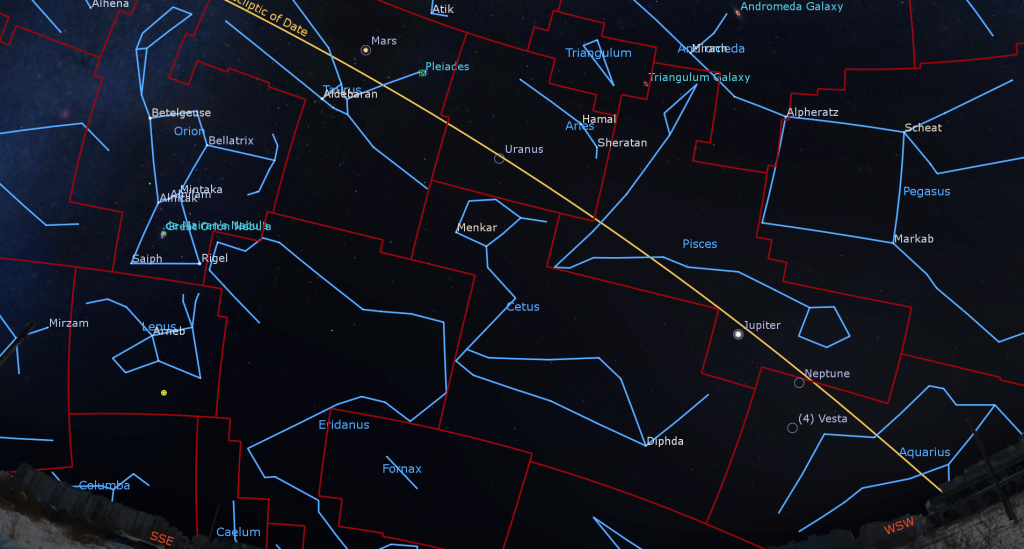
Jupiter will look best in a telescope as soon as you can spot it – while it is still high in the sky. It will sink lower through the evening and set in the west around 10:45 pm local time. Even a small, but decent quality telescope can show you Jupiter’s dark belts and light bands, which are aligned parallel to its equator. With a better grade of optics, Jupiter’s Great Red Spot, a cyclonic storm that has raged for hundreds of years, becomes visible for several hours when it crosses the planet every 2nd or 3rd night. For observers in the Americas, that GRS will cross Jupiter’s disk in early evening on Tuesday, Thursday, and Sunday, and late on Monday, Thursday, and Saturday evening. If you have any coloured filters or nebula filters for your telescope, try enhancing the spot with them.
The round, black shadows of Jupiter’s Galilean moons are visible through a good backyard telescope when they cross the planet’s disk. On Monday evening, January 16 observers living in western Canada and the USA can see the small shadow of Io cross the equator of the planet, accompanied by the GRS, from 9:18 pm to 11:20 pm CST. On Thursday evening, Europa’s tiny shadow will cross from 8:15 pm to 10:30 pm MST. The events are widely visible over the western hemisphere. Just adjust these quoted times into your own time zone.
The tiny, blue, magnitude 7.9 speck of Neptune will be located a fist’s width to the lower right (or 10° to the celestial west-southwest) of Jupiter this week. That’s a bit more than halfway to the medium-bright star Hydor (or Lambda Aquarii), which is easy to see in binoculars. Like Jupiter, try to view Neptune while it is higher right after dusk. The large asteroid designated (4) Vesta is travelling several finger widths to the lower left (or celestial south) of Neptune.
As Earth increases our distance from Mars, the planet had become dimmer in the sky and smaller in telescopes – but you can still see the major dark markings on its 12.5 arc-seconds-wide disk through a small, but good quality telescope using a high magnification eyepiece. If you have coloured filters for your telescope, see if the blue, orange, or red one improves the view.
During early evening Mars will be positioned high in the southeastern sky above the stars of Orion (the Hunter) and the very bright, reddish star Aldebaran, which marks the angry eye of Taurus (the Bull). The Pleiades star cluster can be seen less than a fist’s width to Mars’ upper right (celestial west). Up until last Thursday, Mars had been travelling retrograde towards the Pleiades. From now on, Mars will ramp up its regular easterly prograde motion above Aldebaran, and move a bit farther away from the Pleiades each night. Mars will climb very high in the south around 8:30 pm local time (its absolute best telescope viewing time), and then descend westward, allowing early risers to spot it above the western horizon for several hours before dawn.
The distant blue-green planet Uranus is located about one-third of the way from Mars towards Jupiter, or a generous fist’s width to the lower left (or 12.5° to the celestial southeast) of Hamal and Sheratan, the brightest stars in Aries (the Ram). Closer guideposts to Uranus are several medium-bright stars, including Botein (or Delta Arietis), Al Butain II (or Rho Arietis), and Sigma Arietis, which will appear several finger widths from the planet. Those stars mark the feet of the Aries (the Ram). Magnitude 5.7 Uranus will already be high enough for telescope-viewing, in the upper part of the southern sky, after dusk this week. It will climb to its highest point in the southern sky around 7:30 pm local time and then set around 2 am.
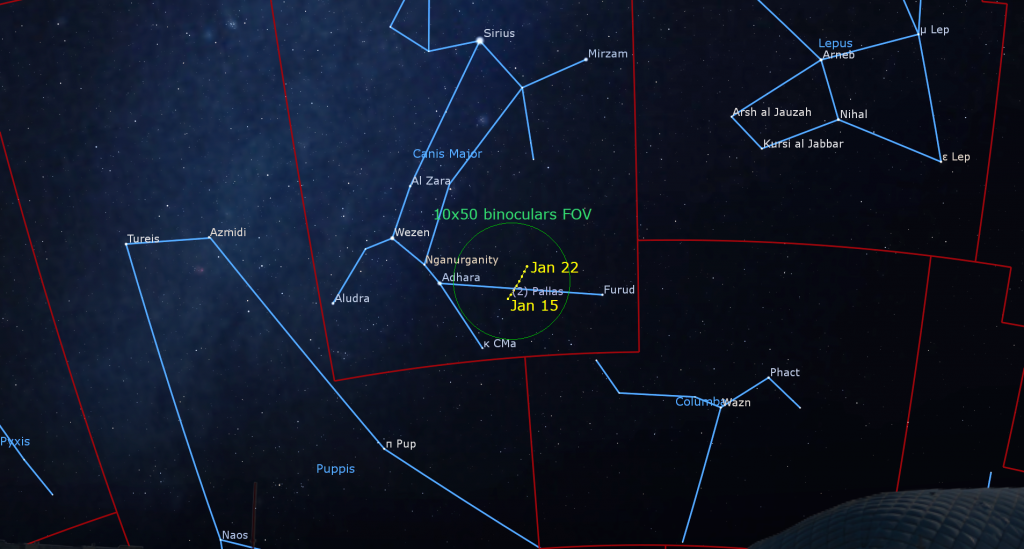
Only one week has passed since last Sunday’s opposition of the main belt asteroid designated (2) Pallas, which still shines with a visual magnitude of 7.7. That’s within reach of binoculars and backyard telescope, but wait until the asteroid has risen higher in late evening for the best views of it. This week Pallas will still be situated in southern Canis Major (the Big Dog), several finger widths to the lower right (or 3.5 degrees to the celestial southwest) of the bright star Adhara. During January and February the asteroid will slide upwards (northwest) through the legs of the dog.
Treats in Taurus
January evenings feature a group of bright and distinctive constellations that are easy to recognize with unaided eyes, and which make winter nights in the Northern Hemisphere worth waiting for. They include Taurus (the Bull), Orion (the Hunter), Auriga (the Charioteer), and Gemini (the Twins). The Winter Milky Way passes through those constellations – populating them with countless delights to view in binoculars or backyard telescopes on moonless nights. Because the evening skies will be nice and dark this week, I’ll guide you through the best sights to see in Taurus. In future Skylights, we’ll tour the other three constellations.
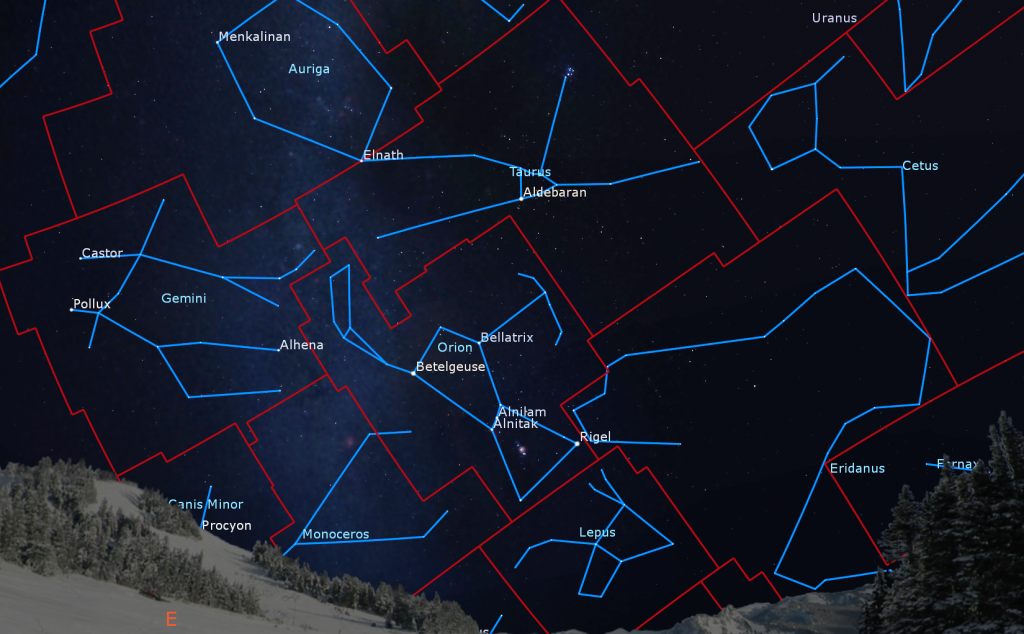
The distinctive constellation of Taurus (the Bull) is perfectly placed for evening exploration in January. It is already halfway up the eastern sky when darkness falls and it crosses the sky for almost the entire night. Taurus contains many wonderful objects to observe in binoculars, and in small or large telescopes – from spectacular star clusters to a supernova remnant, and more. Let’s talk about some of its treats you’ll spy during a winter stroll, and others that make setting up your telescope on a cold winter evening worth your while.
The constellation of Taurus is located on the ecliptic, and just north of the celestial equator, making it visible almost globally. With the dim constellations of Cetus (the Whale), Aries (the Ram), and Aquarius (the Water-Bearer) lying just to the west of it (on the right), Taurus’ much brighter stars make quite an improvement on them. Taurus also borders on Orion (the Hunter), Auriga (the Charioteer), and Gemini (the Twins). Being situation on Taurus’ left-hand (eastern) side, they rise later in the evening. To the north sits Perseus (the Hero), and to Taurus’ lower right (or celestial southwest) is the dim and winding constellation of Eridanus (the River).
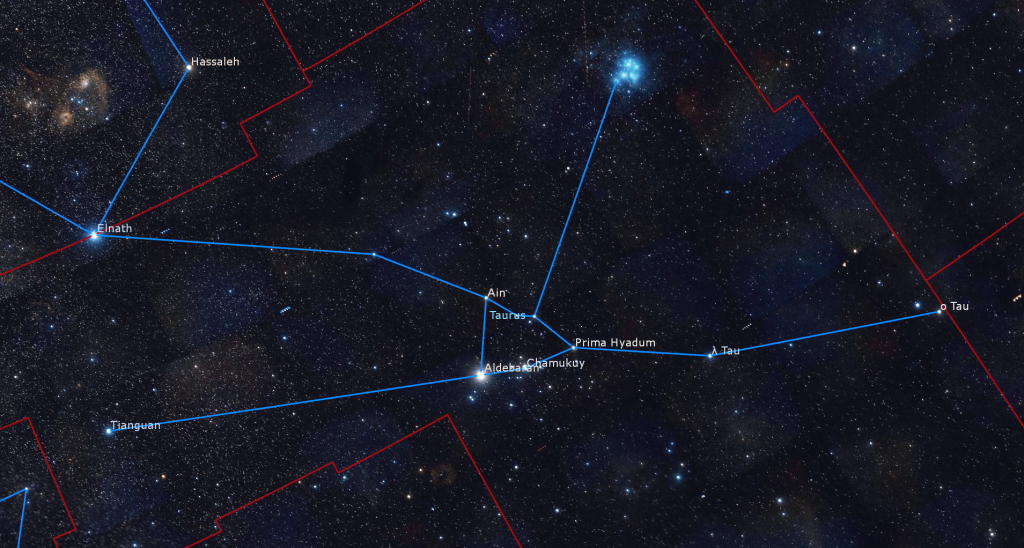
Taurus’ boundary covers a square area of sky that measures about 3.5 fist diameters on each side – except for the southeast corner, which has been assigned to Orion. Taurus is dominated by several elements that combine to make the bull. A large, triangular arrangement of stars form the bull’s face. A very bright, reddish star named Aldebaran sits at the southeastern (lower left) vertex of the triangle, marking his baleful eye. He’s literally seeing red! Two medium-bright stars sitting 1.5 fist diameters to the lower left (east) of his face mark the tips of his horns. Well above the face, the Pleiades star cluster marks his hunched shoulders – and to the southwest, a handful of less prominent stars form his chest and forelegs. The rest of him is missing. When Taurus rises in the east, he is tilted sideways, with his horns down and legs extended – as if he’s charging the twins of Gemini. He doesn’t tilt upright until he enters the western half of the sky near midnight.
Taurus’ very distinctive shape has been recognized since ancient times. It was one of the first constellations to be described. At that time, the spring equinox occurred while the sun was in Taurus. (You can see this by setting an astronomy app’s date to noon on April 9, 2250 BC.) The bull’s strength and fertility were featured in ancient Babylonian and Sumerian myths and legends. In the Mesopotamian Epic of Gilgamesh, the bull was sent to kill Gilgamesh (probably represented by Orion’s stars).
In Greek mythology, Taurus represented Zeus in disguise, seeking to abduct lovely Europa who was charmed by the animal’s power and beauty. It may also have been the Cretan Bull which Hercules slew during his twelve labours. In the Inuit traditions of the far north, Aldebaran represents a polar bear, and the rest of the stars in the triangle are dogs keeping him at bay.

There is a remarkable theory that the stars of Taurus, and nearby Orion’s belt, were incorporated into the ancient paintings found on the Caves of Lascaux in Southern France. The paintings were created somewhere between 8,000 and 17,000 years ago. On the ceiling of the “Salle des Taureaux” or Room of the Bulls, are very large color paintings of horned bulls, one of which has dark facial spots approximating the Hyades, plus a grouping of six stars where the Pleiades should be, and a line of stars resembling Orion’s belt. Even the horns are placed where their stars are found. It’s wonderful to imagine early humans capturing the night sky for posterity!
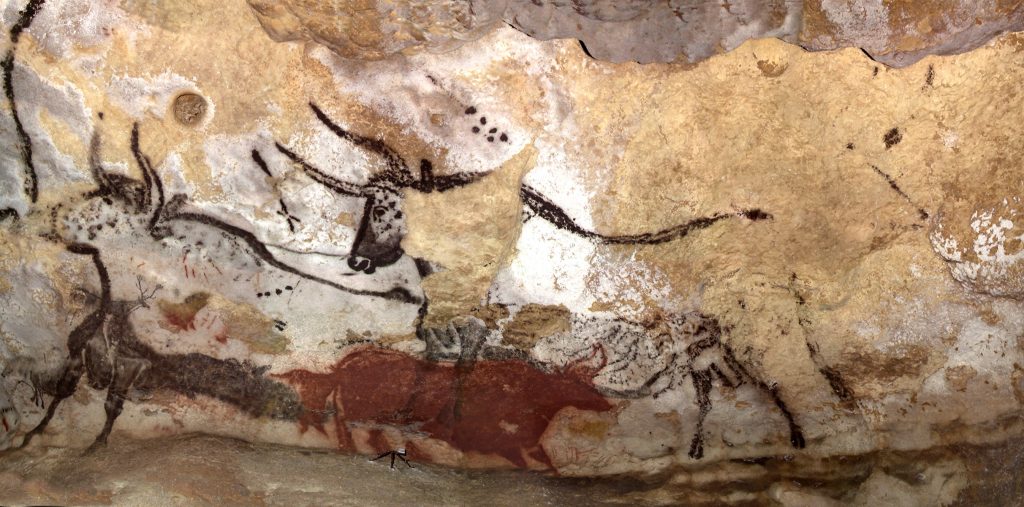
This week, Taurus will rise in mid-afternoon local time, climb high into the southern sky around 9:30 pm, and then descend westward to set around 4:30 am local time. After dusk, you can find him by continuing the line formed by Orion’s belt westwards (upwards in early evening, or to the right later on) by about two outstretched fist diameters (or 20°) until you reach bright Aldebaran. If Orion hasn’t risen yet, you can look high in the east for the little cluster of blue stars of the Pleiades and find Taurus about a fist’s diameter below them (or 12° to the celestial southeast).
Taurus’ triangular face is actually one of the nearest open star clusters to us. Located only about 150 light years away from the sun, it’s called The Hyades. The cluster is named for the daughters of Atlas in Greek mythology, who were associated with rain when they wept for their slain brother Hyas. The cluster actually contains several hundred stars, with a half-dozen or so readily seen under moonless, suburban skies. It’s a lovely target to view in binoculars. Many of its stars are close pairs that astronomers call double stars. By the way, Aldebaran is not part of the cluster. It is less than half as far away!
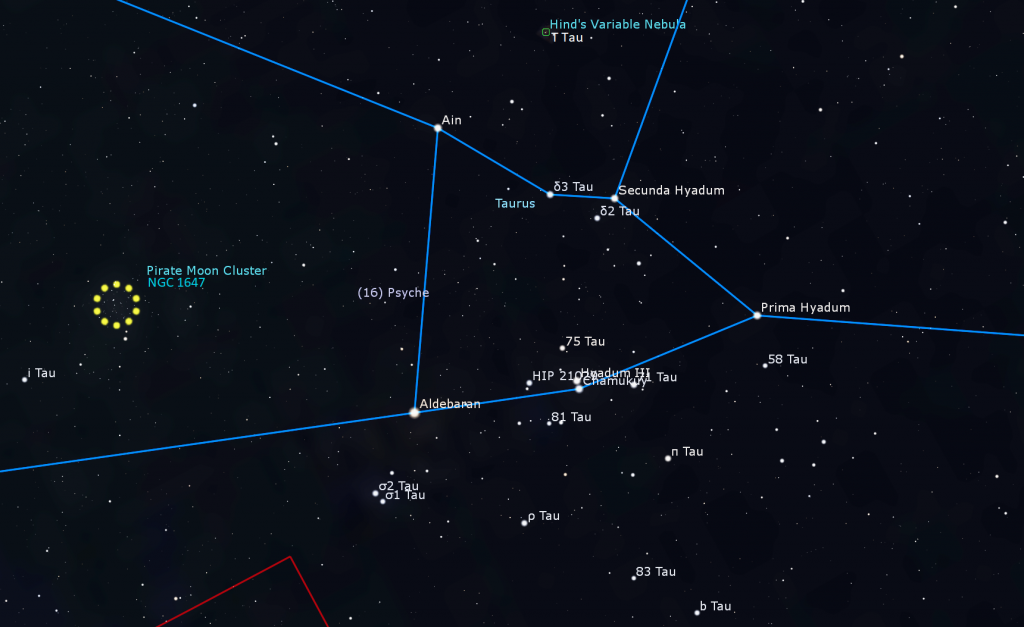
Aldebaran, which means “follower” in Arabic because it chases the Pleiades across the sky, is the brightest star in Taurus. It’s an old orange giant located 65 light-years away from us. Somewhat cooler than our sun, it’s more than twice as massive and 44 times the sun’s diameter because it has exhausted its core Hydrogen and has swelled as it prepares to die. Aldebaran’s position near the ecliptic means that it is frequently occulted (covered) by the moon and visited by the planets as they traverse their orbits.
The beautiful star cluster known as The Pleiades, or the Seven Sisters, which sits about one and a half fist widths above the bull’s face, is one of my favorite wintertime objects. It’s also designated Messier 45 (or M45), part of Charles Messier’s famous list of comet-like objects. The Pleiades is made up of the young, hot blue stars named Asterope (“A-STER-oh-pee”), Merope, Electra, Maia, Taygeta, Celaeno, and Alcyone. And those stars are indeed related – born of the same primordial gas cloud. In Greek mythology, they were the daughters of Atlas, and half-sisters of the Hyades. Only five or six of the sister stars are usually seen with unaided eyes – plus their parent stars Atlas and Pleione huddled together at the east end of the grouping.
The Pleiades cluster is located about 450 light years away from the sun, and it, too makes a wonderful target in binoculars or a telescope at low magnification, where many more siblings are revealed! A large telescope under dark skies will also reveal blue nebulosity around the stars – reflected light from unrelated gas and dust that the stars are passing through. Galileo was among the first to observe the cluster in a telescope. In 1610, he published a sketch made at the eyepiece.
The Pleiades cluster is located about 450 light years away from the sun. The cluster’s stars are mainly hot, young, blue-white spectral class B giants and sub-giants that formed together about 100 million years ago. The object is best observed in a widefield telescope at low magnification, which can reveal up to 500 stars within a 2 degree field – many of them doubles and multiples. The cluster is passing through a dusty region of the galaxy. This proper motion will eventually carry the cluster below Orion’s feet. The light from the brightest stars reflects off the dust and produces a blue halo around them. That nebulosity is visible in large aperture telescopes and long exposure photographs.
Not surprisingly, many cultures, including Aztec, Maori, Sioux, Hindu, and more, have noted this object and developed stories around it. Many indigenous groups saw the Pleiades as the doorway in to the afterlife, or the portal through which humans first fell to Earth – naming it the Hole in the Sky. In Japan, it is called Suburu (スバル in katakana), and forms the logo of the eponymous car maker. Due to its similar shape and diminutive size, some people mistake the Pleiades for the Little Dipper. While the shapes are similar, the Little Dipper is twenty times larger than the Seven Sisters!
The star Elnath, or Alnath, which translates to “the butting one”, is an old, bright, hot blue giant star located 130 light-years away from our sun. It marks the bull’s higher (more northerly) horn tip. On the border of Taurus and Auriga (the Charioteer), it’s one of only two stars in the sky that are shared by two constellations. (The other is Alpheratz in Andromeda/Pegasus.)
The bull’s lower horn tip star is less bright, but is still readily seen by eye. It was once referred to as Shurnarkabti-sha-shūtū “the star in the bull towards the south”, but nowadays it’s simply called Zeta Tauri (or ζ Tau) or Tianguan. This star is a hot blue subgiant – 420 light-years away, but radiating 6,700 times the light of our sun. Zeta is a candidate to explode one day in a supernova burst – ironic since it sits very close to a supernova remnant, the Crab Nebula (more on this below).
The Hyades contains a number of nice double stars. Two degrees to the right of Aldebaran (towards the bull’s chin), look with unaided eyes or binoculars for the close-together pair of stars designated Theta 1 and 2 Tauri. The higher one is slightly more yellow. Also easy, on the opposite cheek are three widely spaced stars all designated Delta Tauri. Some apps label them as Hyadum II, Delta 2, and Cleeia or Delta 3. A finger’s width below Aldebaran, hunt with binoculars for the close pair of white stars named Sigma 1 and 2.
Here are a few more interesting objects to hunt for if you have a large telescope. The dim star named 47 Tauri sits about a fist’s diameter to the lower right (or 9 degrees to the celestial southwest) of Aldebaran. It’s a close pair of unevenly bright yellow stars. Farther west, look for T Tauri, a very young star recently formed and still surrounded by some of its protostellar disk, often named Hind’s Variable Nebula. Lambda Tauri is a fairly bright star located five degrees to the lower right of the bull’s chin. This is an eclipsing binary variable star that dims in brightness for 1.1 days every 4 days because it has an orbiting dim companion star that blocks some of the main star’s light when it crosses between us and the star. Some apps mane it as Elthor “the bull”.
The supernova remnant now known as the Crab Nebula (or Messier 1) sits a finger’s width above Zeta Tauri. Nowadays, you need a very large telescope to see the remnant as a dim, fuzzy patch – but on July 4, 1054 AD Chinese astronomers recorded that the star that exploded to create the Crab Nebula shone bright enough to see it in the daytime for three weeks! Then it faded to become the brightest night time star for a few months. The object is about 6,500 light-years from the sun.

Here’s one more treat. A very red, magnitude 4.3 star named the Ruby Star (or 119 Tauri) sits 2.7 finger widths to the right of Zeta Tauri. It’s a variable star that pulsates every 165 days. There are even more sights to see in Taurus. You should be able to find it easily in binoculars.
The open star clusters NGC 1746 and NGC 1647 sit between the bull’s horns. A close-together pair of clusters NGC 1817 and NGC 1807 sit two finger widths below the mid-point of the line connecting Zeta Tauri and Aldebaran. The outer rim of the Milky Way passes just beyond Taurus’ horn tips, and that area will reward scanning with binoculars or telescope, too.
The Bright Stars of January
If you missed last week’s tour of winter’s brightest stars, I post it with sky charts showing where each of the stars are here.
Public Astro-Themed Events
Every Monday evening, York University’s Allan I. Carswell Observatory runs an online star party – broadcasting views from four telescopes/cameras, answering viewer questions, and taking requests! Details are here. They host in-person viewing on the first clear Wednesday night each month. On Wednesdays they stream views online via the observatory YouTube channel. Details are here.
On Wednesday evening, January 18 at 7:30 pm EDT, the RASC Toronto Centre will live stream their monthly Speakers Night meeting. This month will Dr. L. Arielle Phillips, Associate Dean College of Science Associate, Professor of the Practice of Physics and Astronomy, University of Notre Dame. Her talk is titled The dim and empty places: unveiling the nature of the universe in spectacularly modest environments. Everyone is invited to watch the presentation live on the RASC Toronto Centre YouTube channel. Details are here.
My free, family-friendly Insider’s Guide to the Galaxy webcast with Samantha Jewett of RASC National returns on Tuesday, January 17 at 3:30 pm EST. We’ll highlight the best celestial events of 2023, and we’ll highlight the next batch of RASC’s Finest NGC objects. You can find more details and the schedule of future sessions here.
Keep looking up, and enjoy the sky when you do. I love questions and requests. Send me some!